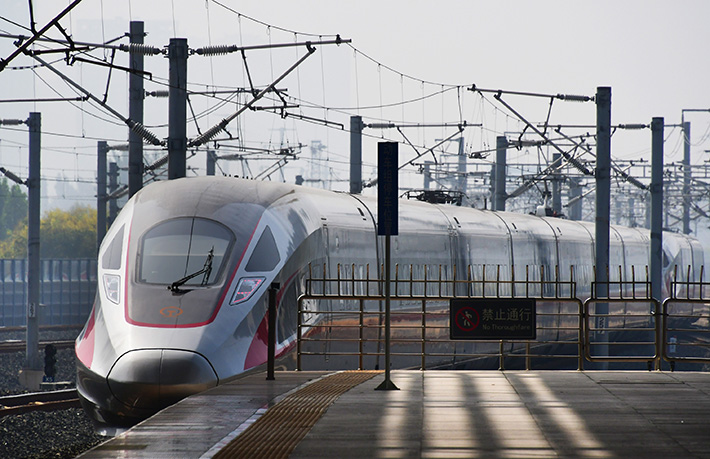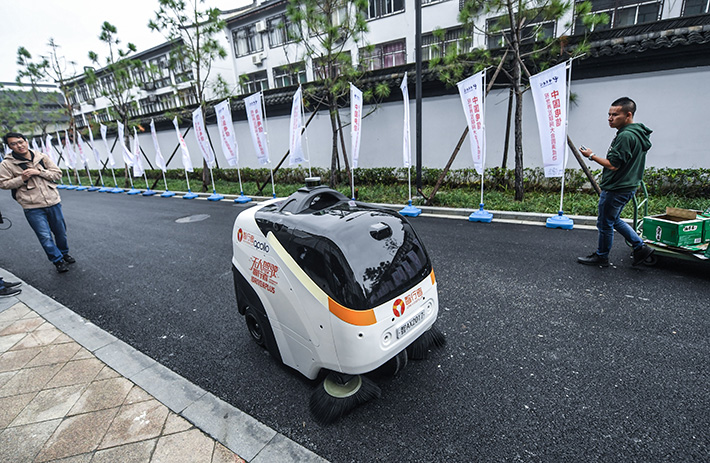|
||||||||||
| Home Nation World Business Opinion Lifestyle ChinAfrica Multimedia Columnists Documents Special Reports |
|
||||||||||
| Home Nation World Business Opinion Lifestyle ChinAfrica Multimedia Columnists Documents Special Reports |
| ChinAfrica |
| Hi-Tech Revolution |
| The rise of China's scientific and technological development |
| By Ge Lijun | VOL.10 December ·2018-12-04 |

China’s high-speed trains between Beijing and Shanghai run at 350 km per hour (XINHUA)
The announcer on the giant screen greeted visitors to the Wuzhen International Internet Exhibition Center with a cheery voice. "Good morning everyone! I will be your news anchor for today," said the male voice. But this was no ordinary announcer: his voice and appearance have been entirely generated by artificial intelligence technology.
Such "virtual announcer" was one of the highlights of the Fifth Light of the Internet Exhibition during the annual World Internet Conference, held in Wuzhen Township, in east China's Zhejiang Province on November 6-10. Every year during the exhibition, 5G technology, artificial intelligence, cloud computing, big data, smart medical care and other scientific buzzwords take a tangible form and materialize in a series of innovative products.
Science and technology are like a breath of fresh air blowing over Wuzhen, a thousand-year-old township. Tourists from all over the world can experience the convenience provided by the most advanced technologies, such as the 4G network covering the entire township and free public WiFi coverage in key public places. Even seniors who sell street food collect money with QR codes. Technology is everywhere.
According to China's Ambassador to Mexico Qiu Xiaoqi, science and technology have become the main productive forces in China, while innovation has become a major driver of development. Over the years, China has gone from strengthening its capacity for independent innovation to building itself into an innovative country, he said.
This renewed scientific and technological capacity has progressed hand in hand with economic development, which has greatly contributed to the improvement of China's overall national strength, Qiu said.
Impressive progress
"We should speed up the development of the digital economy and promote the global Internet governance system to advance in a just and more reasonable way, so as to inject new impetus to the world economy," said Chinese President Xi Jinping in his congratulatory letter to the World Internet Conference on November 6.
In 1978 when China first launched reform and opening up, most Chinese railways still used steam locomotives with an average speed of 40 km per hour. After years of hard work, the first Beijing-Tianjin intercity high-speed rail (HSR) officially opened in 2008. In just 10 years, Chinese HSR operate the fastest trains in the world.
Coverage of the Chinese rail network went from 52,000 km in 1978 to 127,000 km at the end of 2017, an increase of 144.2 percent. This includes 25,000 km of high-speed lines, accounting for 66.3 percent of the global total.
"Thanks to HSR, the trip from Beijing to my hometown has been reduced by six hours!" said Li Wenshui, a student in Beijing from east China's Shandong Province. In addition, the sale of HSR to Southeast Asia and Central Asia has become an important part of Chinese international cooperation, in what is called "railway diplomacy."
In fact, these scientific and technological achievements all stem from a common element: innovation. According to Wang Zhigang, China's Minister of Science and Technology, the link between technological innovations and supply-side structural reform has accelerated scientific and technological breakthroughs and effectively promoted industrial upgrading. The contribution of scientific and technological progress to China's economic growth now reaches 57.5 percent, he added.
Technologies such as big data, cloud computing and artificial intelligence have become the driving force behind the emergence of China's digital economy and shared economy. In 2017, the number of hi-tech companies in China reached 136,000, and the technology contractual value amounted to 1.34 trillion yuan ($193 billion). These advances have also contributed to poverty reduction efforts and rural revitalization. For example, the contribution of improved seeds to China's crop production has now exceeded 43 percent.
And this would not have been possible without human resources, which is the most precious factor for technological innovation, according to experts. Since reform and opening up, China has vigorously implemented the country's rejuvenation strategy through science and education. To this end, China has increased the number of its scientific and technological workforce from 674,300 in 1992 to 6.21 million in 2017.
Extended cooperation
When the reform and opening up policy was first launched in December 1978, China was quick to sign a number of scientific and technological cooperation agreements with countries such as France, the United Kingdom and the United States, opening up new channels for exchange with the outside world. Over the past 40 years, China has forged ties in scientific and technological cooperation with 158 countries and signed 112 agreements in this area, according to figures released by the Ministry of Science and Technology.
As China continues to open up its market, the level and methods of its cooperation continue to grow. On the one hand, a large number of foreign-invested enterprises have entered China, with their investments gradually expanding from processing and manufacturing sectors to hi-tech areas such as computer and intelligent manufacturing. On the other hand, more and more Chinese companies have been "going out," moving up from basic construction projects at first, to now providing complete sets of equipment and services.
Over the last two years, Beijing's Zhongguancun District, often called China's Silicon Valley, has set up a series of international innovation and incubation platforms, such as the Zhongguancun-Paris Region Innovation Industrialization Center and the China-Italy Innovation Center, helping foreign entrepreneurs to find Chinese partners and vice versa.
"Zhongguancun District is a window and a center of China's science and technology development. We want to transform it into a two-way platform: to attract foreign advanced technologies to China and to help Chinese technologies go abroad," said Nie Lixia, Executive Director of
China's Global Tech Contribution
The Chinese Academy of Science and Technology for Development recently published a blue book entitled Growing up in Reform and Opening up, which contains a set of data that illustrates the contribution of China's scientific and technological progress to the world since the policy of reform and opening up was launched in China 40 years ago. According to the blue book, since the beginning of the 21st century, China's R&D investment has increased from 89.6 billion yuan ($12.9 billion) in 2000 to 1.75 trillion yuan ($252 billion) in 2017, accounting for 2.12 percent of the country's GDP.

A robot cleans the street in Wuzhen during the Fifth World Internet Conference in early November (XU YU)
(Comments to glj@chinafrica.cn)
| About Us | Contact Us | Advertise with Us | Subscribe |
| Copyright Beijing Review All rights reserved 京ICP备08005356号-5 京公网安备110102005860号 |